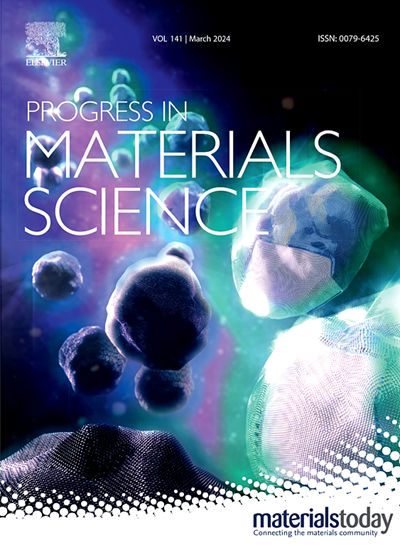光学传感器阵列的金属-有机框架
IF 40
1区 材料科学
Q1 MATERIALS SCIENCE, MULTIDISCIPLINARY
引用次数: 0
摘要
精确地识别各种分析物之间细微的结构差异仍然是一项至关重要但又困难的努力,主要是因为它们的广泛多样性、结构相似性和相互干扰的可能性。传统的传感器,其操作的“锁和钥匙”原则,提供高选择性和特异性检测特定的分析物。然而,这种设计使它们不适合同时检测多种分析物。金属有机框架(mof)由于其不同的金属节点和配体,以及可以封装在其通道或孔内的客体物质,在光学传感器阵列领域引起了相当大的兴趣。这种通用性使得mof在开发多通道单传感元件传感器阵列方面非常有利。本文主要综述了基于mof的光学传感器阵列的内在结构-性能关系及其发展现状。首先,本文简要介绍了光学传感器阵列的基本理论和操作步骤。其次,详细介绍了交叉反应传感元件的构建策略。第三,全面探讨了基于mof的光学传感器阵列在目标分析物识别和检测中的应用。这包括它们在环境监测、疾病诊断、食品质量评估和复杂系统分析中的应用。最后,对基于mof的光学传感器阵列的现有局限性和未来的研究机会进行了深入的分析。本文章由计算机程序翻译,如有差异,请以英文原文为准。


Metal-Organic frameworks for optical sensor arrays
Precisely identifying subtle structural distinctions among various analytes remains a crucial yet difficult endeavor, primarily due to their extensive diversity, structural resemblance, and the potential for mutual interference. Traditional sensors, which operate on the “lock-and-key” principle, offer high selectivity and specificity for detecting particular analytes. However, this design makes them unsuitable for the simultaneous detection of multiple analytes. Metal-organic frameworks (MOFs) have attracted considerable interest in the realm of optical sensor arrays due to their diverse metal nodes and ligands, as well as the guest species that can be encapsulated within their channels or pores. This versatility makes MOFs highly advantageous for developing multi-channel single-sensing-element sensor arrays. The primary emphasis of this comprehensive review is on the intrinsic structure-performance relationship and development status of MOF-based optical sensor arrays. First, this review offers a concise explanation of the underlying theory and operational steps involved in optical sensor arrays. Second, the construction strategies for cross-reactive sensing elements are thoroughly presented. Third, the applications of MOF-based optical sensor arrays in identifying and detecting target analytes are explored comprehensively. This includes their use in environmental monitoring, disease diagnosis, food quality assessment, and the analysis of complex systems. Finally, the existing limitations and future research opportunities concerning MOF-based optical sensor arrays are thoroughly examined.
求助全文
通过发布文献求助,成功后即可免费获取论文全文。
去求助
来源期刊

Progress in Materials Science
工程技术-材料科学:综合
CiteScore
59.60
自引率
0.80%
发文量
101
审稿时长
11.4 months
期刊介绍:
Progress in Materials Science is a journal that publishes authoritative and critical reviews of recent advances in the science of materials. The focus of the journal is on the fundamental aspects of materials science, particularly those concerning microstructure and nanostructure and their relationship to properties. Emphasis is also placed on the thermodynamics, kinetics, mechanisms, and modeling of processes within materials, as well as the understanding of material properties in engineering and other applications.
The journal welcomes reviews from authors who are active leaders in the field of materials science and have a strong scientific track record. Materials of interest include metallic, ceramic, polymeric, biological, medical, and composite materials in all forms.
Manuscripts submitted to Progress in Materials Science are generally longer than those found in other research journals. While the focus is on invited reviews, interested authors may submit a proposal for consideration. Non-invited manuscripts are required to be preceded by the submission of a proposal. Authors publishing in Progress in Materials Science have the option to publish their research via subscription or open access. Open access publication requires the author or research funder to meet a publication fee (APC).
Abstracting and indexing services for Progress in Materials Science include Current Contents, Science Citation Index Expanded, Materials Science Citation Index, Chemical Abstracts, Engineering Index, INSPEC, and Scopus.
 求助内容:
求助内容: 应助结果提醒方式:
应助结果提醒方式:


